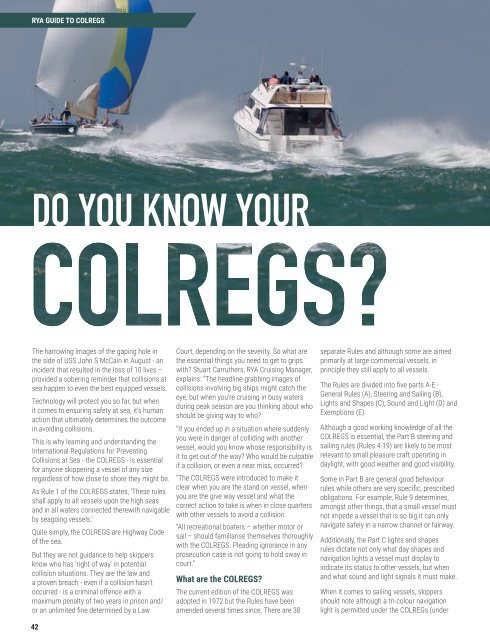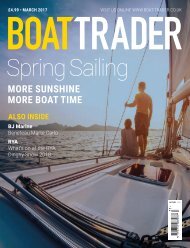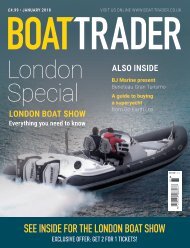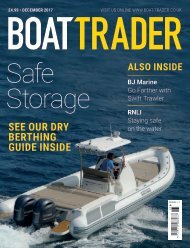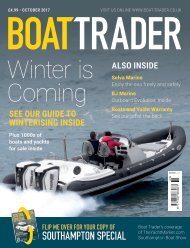Create successful ePaper yourself
Turn your PDF publications into a flip-book with our unique Google optimized e-Paper software.
RYA GUIDE TO COLREGS<br />
DO YOU KNOW YOUR<br />
The harrowing images of the gaping hole in<br />
the side of USS John S McCain in August - an<br />
incident that resulted in the loss of 10 lives –<br />
provided a sobering reminder that collisions at<br />
sea happen to even the best equipped vessels.<br />
Technology will protect you so far, but when<br />
it comes to ensuring safety at sea, it’s human<br />
action that ultimately determines the outcome<br />
in avoiding collisions.<br />
This is why learning and understanding the<br />
International Regulations <strong>for</strong> Preventing<br />
Collisions at Sea - the COLREGS - is essential<br />
<strong>for</strong> anyone skippering a vessel of any size<br />
regardless of how close to shore they might be.<br />
As Rule 1 of the COLREGS states, ‘These rules<br />
shall apply to all vessels upon the high seas<br />
and in all waters connected therewith navigable<br />
by seagoing vessels.’<br />
Quite simply, the COLREGS are Highway Code<br />
of the sea.<br />
But they are not guidance to help skippers<br />
know who has ‘right of way’ in potential<br />
collision situations. They are the law and<br />
a proven breach - even if a collision hasn’t<br />
occurred - is a criminal offence with a<br />
maximum penalty of two years in prison and/<br />
or an unlimited fi ne determined by a Law<br />
42<br />
Court, depending on the severity. So what are<br />
the essential things you need to get to grips<br />
with? Stuart Carruthers, RYA Cruising Manager,<br />
explains: “The headline-grabbing images of<br />
collisions involving big ships might catch the<br />
eye, but when you’re cruising in busy waters<br />
during peak season are you thinking about who<br />
should be giving way to who?<br />
“If you ended up in a situation where suddenly<br />
you were in danger of colliding with another<br />
vessel, would you know whose responsibility is<br />
it to get out of the way? Who would be culpable<br />
if a collision, or even a near miss, occurred?<br />
“The COLREGS were introduced to make it<br />
clear when you are the stand on vessel, when<br />
you are the give way vessel and what the<br />
correct action to take is when in close quarters<br />
with other vessels to avoid a collision.<br />
“All recreational boaters – whether motor or<br />
sail – should familiarise themselves thoroughly<br />
with the COLREGS. Pleading ignorance in any<br />
prosecution case is not going to hold sway in<br />
court.”<br />
What are the COLREGS?<br />
The current edition of the COLREGS was<br />
adopted in 1972 but the Rules have been<br />
amended several times since. There are 38<br />
separate Rules and although some are aimed<br />
primarily at large commercial vessels, in<br />
principle they still apply to all vessels.<br />
The Rules are divided into fi ve parts A-E -<br />
General Rules (A), Steering and Sailing (B),<br />
Lights and Shapes (C), Sound and Light (D) and<br />
Exemptions (E).<br />
Although a good working knowledge of all the<br />
COLREGS is essential, the Part B steering and<br />
sailing rules (Rules 4-19) are likely to be most<br />
relevant to small pleasure craft operating in<br />
daylight, with good weather and good visibility.<br />
Some in Part B are general good behaviour<br />
rules while others are very specifi c, prescribed<br />
obligations. For example, Rule 9 determines,<br />
amongst other things, that a small vessel must<br />
not impede a vessel that is so big it can only<br />
navigate safely in a narrow channel or fairway.<br />
Additionally, the Part C lights and shapes<br />
rules dictate not only what day shapes and<br />
navigation lights a vessel must display to<br />
indicate its status to other vessels, but when<br />
and what sound and light signals it must make.<br />
When it comes to sailing vessels, skippers<br />
should note although a tri-colour navigation<br />
light is permitted under the COLREGs (under


